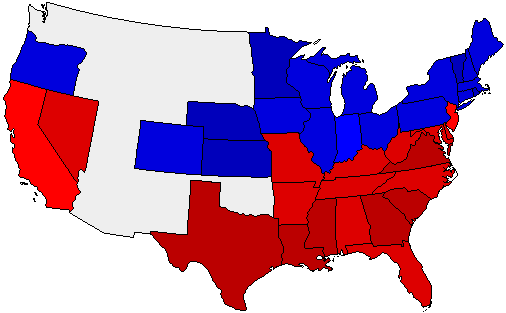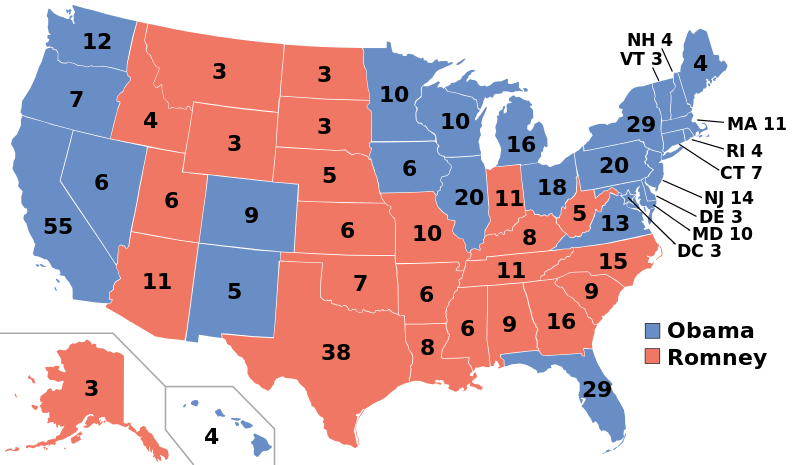Electoral changes: North, South, East, West, inland, coast
Just for fun, I randomly chose an election year from the past to compare to recent ones. Here’s the map for the presidential race of 1880:
Fifteen years after the Civil War, you can see an exceptionally dramatic North/South polarization. And yet, if you look at the vote percentages state-by-state, you’ll find that in no state was the winner’s take more than around 65%, and most were much closer than that (except for Vermont, which went for the Republican Garfield at close to 70%, so I guess Vermont was always a state of extremes).
Fast forward to 2012. Here’s the map:
There’s still pretty much of a north/south split in the east, but in the west it’s not the same split. And in the east, the parties are almost exactly reversed from where they used to be. For 2012, if you look at the state-by-state percentages (you have to scroll down at the link to do it), you’ll find that, curiously, it’s still the case that for the most part the figures hover around a ceiling in the 60-percentage range, with a couple of outliers at around 70. Hawaii, Obama’s home state, gave him 70 and a fraction, whereas Utah (Mormon and conservative stronghold) voted at around 73% for Romney. Only the District of Columbia (which was barred from voting for president back in 1880) is an all-Democrat-all-the-time outlier at around 91%.
Except for that DC vote—explained,I believe, by its large inner-city black population coupled with its career federal bureaucrat population—there seems to be a mysterious in-state partisanship ceiling of roughly two-thirds which has held stable over time. I’m not sure why this would be; any ideas?



Could it be explained by “groupthink”?
A lot of folks tend to agree with those around them. Going against “the norm” is somewhat rare, no? Don’t a lot of people (aside from the rare independent thinker) want to be like others around them?
Since so many folks are really apolitical, they want to conform so as to be accepted; so this would even include one’s political view.
One reason for this pattern in recent years is that states have some balance between urban and rural population. Rural Connecticut votes like rural Mississippi; ditto with urban Connecticut and Mississippi. The outlier you mention, DC, has no rural population to balance its urban. (That’s why it ranks so badly among “states” in a lot of areas, but ranks only somewhat badly among cities.)
Another thing: if a presidential candidate wins a state with 70%, then someone’s not doing his job. Staff is paid to make sure that the minimum amount of time and money is spent in each state in order to secure a win. If Alabama is yours, don’t go down there and try to win more votes. If you’re close in Colorado, make sure you get into “safe”. The dream is to win 51% of the vote in enough states to win 51% of the electors. The rest of the money goes to more needy races or future races.
Any wonder why we don’t see signs of national consensus?
I said that you don’t want to waste time or money. Let me add one other resource you don’t want to waste: positions. The modern presidential campaign wants to hold only those positions that will win that 51%. If you’re running low, sell off a belief. Pick up or drop agenda items to win over or alienate people as needed.
Of course it is well understood that the split is not really along state lines; although the electoral vote may go that way.
In California, large swaths of the state lean GOP but are over powered by the coastal “elites” and the big city welfare population.
Virginia has become an even starker example. The traditional Virginia electorate is swamped by the heavily populated, heavily invested in federal government, DC suburbs. These suburban areas are again augmented by the welfare dependent cities, like Norfolk and Richmond. Forty miles from DC, the county I recently moved from reliably votes GOP election after election.
It is little wonder that there is sentiment to break states into parts, because large areas of so many states feel that there is no chance for representation. Would that it could happen, but the chances are slim and none. After all, the money and infrastructure resources in states such as California are controlled by Democrats. Would they share with a break away entity? What a silly question.
Two-thirds is a huge landslide. It is two to one. Anything beyond that transcends competitive and verges into monolithic.
One small error bothers me. You call the map a recap of the 2012 election, but it compares the votes for Obama and McCain. Call me crazy, but I thought Romney ran in 2012 and McCain ran in 2008.
John in Palm Springs:
Oops! I put the wrong year map up. I’ll change it to 2012, which is actually very similar. Thanks!
I see the the bigggest current split between Demo and Pub as being between urban and rural. As Oldflyer points out, rural California votes Pub while the big metro areas vote Demo.
I suspect that in much of the Northeast, the rural counties which voted Pub in 1876 are still voting Pub. The difference is that the Demo cities now outvote them. The same should follow for the Midwest. Certainly downstate Illinois is currently a Pub stronghold, as it probably was in 1876.
For comparison. New England- near complete switchover. Midwest- some switched, some didn’t.
Sooutm complete switchover.
https://en.wikipedia.org/wiki/File:PresidentialCounty1876.gif
https://en.wikipedia.org/wiki/File:2012nationwidecountymapshadedbypercentagewon.svg
I don’t know what neo’s source is, but anyone wants to look this stuff over, the obvious source is
Dave Leip’s Election Atlas
I know she didn’t use Dave simply because Dave hasn’t reversed the color scheme like the media did ca. 1998 or so, to eliminate the “Dems=Reds” connection.
Dave still uses the traditional GOP=Blue, Dems=Reds, that has been the standard for many decades.
With Dave, you can break it down to the county level most of the time, going back for a long while.
The county level is more interesting to me. It shows a pretty clear pattern of high density urban areas leaning heavily Democrat. I’m not entirely sure why, but I suspect it’s an unholy fusion of those who live off of the government and the controlling entities who profit most from currying favor with the State. Such people aren’t exclusively Democrat, but they seem overwhelmingly so, and why not? The State treats them well as subjects or middle management. Supporting a strong State is only natural if you’re in such a protected class.
At least, until it turns on you.
Tesh – More like rich liberals and poor minorities.